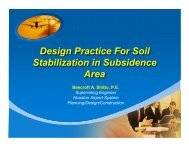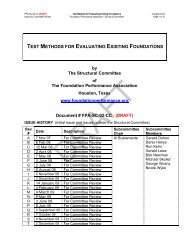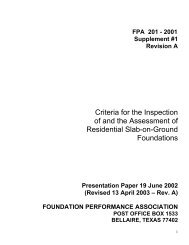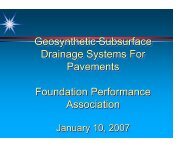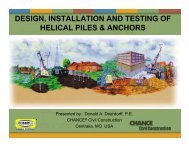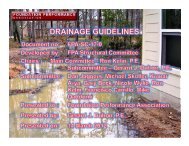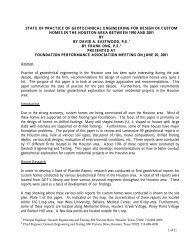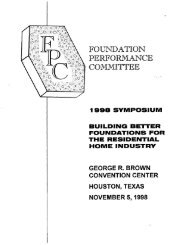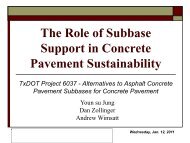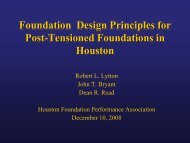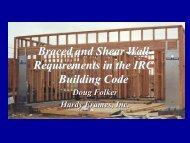Soil-Structure Interaction Seminar - Foundation Performance ...
Soil-Structure Interaction Seminar - Foundation Performance ...
Soil-Structure Interaction Seminar - Foundation Performance ...
You also want an ePaper? Increase the reach of your titles
YUMPU automatically turns print PDFs into web optimized ePapers that Google loves.
Area drains can be used around the house to minimize ponding of the surface water next to the<br />
foundations. The area drains should be checked periodically to assure that they are not clogged.<br />
The drains should be provided with outlets or sumps to collect water and pumps to expel water<br />
if gravity drainage away from the foundation is not feasible. Sumps should be located well away<br />
from the structure. Drainage should be adequate to prevent any water from remaining in the<br />
drain (i.e., a slope of at least 118 inch per foot of drain or 1 percent should be provided).<br />
Positive drainage should be established underneath structural slabs with crawl space. Absence<br />
of positive drainage may result in surface water ponding and moisture migration through the<br />
• slab. This may result in floor slab warping (in the case of wood floors) and tile unsticking.<br />
It is recommended that at least six-inches of clearing be developed between the grading and the<br />
wall siding. This will minimize surface water entry between the foundation and the wall<br />
material, promoting wood decay.<br />
Poor drainage at residential projects in North and West Houston can result in saturation of the<br />
surficial sands and development of a perched water table. The sands, once saturated, can lose<br />
their load carrying capacity. This can result in foundation settlements and bearing capacity<br />
failures. <strong>Foundation</strong>s in these areas should be designed assuming saturated subsoil conditions.<br />
In general, gutters are recommended all around the roof line. The gutters and downspouts<br />
should be unobstructed by leaves and tree limbs. In the area where expansive soils are present,<br />
the gutters should be connected to flexible pipe extensions so that the roof water is drained at<br />
least 10-feet away from the foundations. Preferably the pipes should direct the water to the<br />
storm sewers. In the areas where sandy soils are present, the gutters should drain the roof water<br />
at least five-feet away from the foundations. If a roof drainage system is not installed, rainwater<br />
will drip over the eaves and fall next to the foundations where poorly compacted backfill<br />
fissures and slickensides in the soil mass may allow the water to seep directly into the areas of<br />
the foundation and floor slabs.<br />
Landscaping<br />
A house with the proper foundation, and drainage can still experience distress if the homeowner<br />
does not properly landscape and maintain his property. One of the most critical aspects of<br />
landscaping is the continual maintenance of properly designed slopes.<br />
Planting flower beds or shrubs next to the foundation and keeping the area flooded will result<br />
in a net increase in soil expansion in the expansive soil areas. The expansion will occur at the<br />
foundation perimeter. It is recommended that initial landscaping be done on all sides, and the<br />
drainage away from the foundation should be provided and maintained. Partial landscaping on<br />
one side of the house may result in swelling on the landscaping side of the house and resulting<br />
differential swell of foundation and structural distress in a form of brick cracking, windows/door<br />
sticking, and slab cracking.<br />
GE01ECH ENGINEERING AND TESTING, INC. -------------·<br />
20



